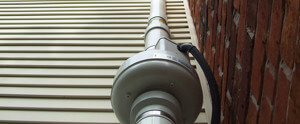Lung Cancer Victims Blame Radon: Call Government Policy a “Deadly and Impotent Failure”
Senate bill to reduce lung cancer ignores radon gas. Radon is the #2 cause of lung cancer.
Written by Linda Kincaid, MPH, CIH
Published on February 7th, 2009
Liz Hoffman learned she had lung cancer at 37. She never smoked. She had no family history of cancer. She believes her lung cancer was caused radon gas in her home. Dennie Edwards, an Ohio real estate agent, learned he had 10 picoCuries/liter of radon in his home, 2 ½ times the EPA action level. Two days later, surgeons removed his entire left lung. Dennie passed away last June.
Ms. Hoffman founded Cancer Survivors Against Radon (CanSAR) to "put a face on radon". She hopes that stories like hers will convince people to test their homes for radon and mitigate if needed.
"HUD requires a termite letter to qualify for a mortgage, yet to my knowledge a termite never killed anybody", comments Dr. Lane Mathis Price (Decatur General Oncology Center). "Why are they not requiring a radon test?" Dr. Michael Dick (Decatur Adult Medicine) adds, "you'd be kicking yourself if you knew something as simple as a radon detection device would have allowed you to prevent this from occurring."
Liz Hoffman shared her lung cancer experience on Minneapolis television, prompting over 30,000 viewers to test their homes for radon. The publicity brought legislation in Minnesota requiring radon-resistant construction in new homes. Gloria Linnertz also turned to the media after her husband died from lung cancer. Her appearance on Chicago television encouraged passage of the Illinois Radon Awareness Act.
Unfortunately, the U.S. now has more homes with elevated radon than when the EPA Radon Program was established 22 years ago. Dr. Jay Lubin (National Cancer Institute) estimates, "Between 10 percent and 14 percent of all lung cancer deaths per year may be attributable to radon".
Epidemiologist Dr. William Field (University of Iowa) goes further, calling radon a "dirty bomb within our homes" and a "bioterrorist within". Radon-resistant construction methods cost about $550 per home. Reducing indoor radon to 2 pCi/L could save 10,000 lives each year.
Proposed legislation ignores the 10,000 lung cancer deaths that could be prevented each year. Senator Diane Feinstein (D-CA) introduced S332, the Lung Cancer Mortality Reduction Act of 2009. Radon is not mentioned in the 12-page document. Instead, the bill calls for increased funding for drug research and treatment methodologies.
Pharmaceutical companies do not need additional profits. Lung cancer victims do not want to learn, after they are diagnosed, that their cancers could have been prevented. Senator Feinstein or committee members can modify the existing bill to focus on prevention.
On February 11, I will meet with Senator Feinstein's assistant, Kristin Wikelius in Washington DC. In that meeting, I will encourage a shift in S332 toward lung cancer prevention. I invite concerned readers to add their voices to mine.
Contact information:
Sponsor: Dianne Feinstein, Kristin Wikleius (Assistant)
Co-sponsors: Tom Brownback, Debbie Stabenow
Current Committee: HELP Committee




